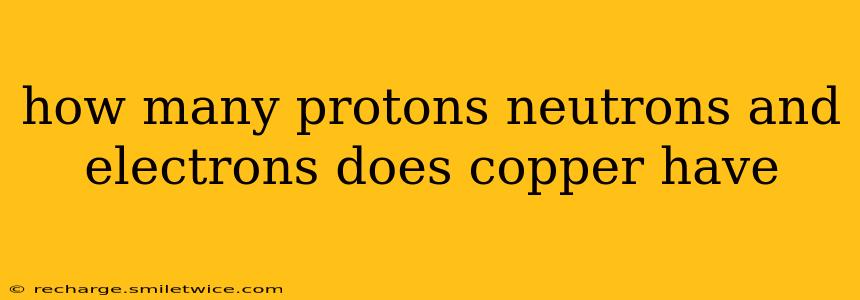How Many Protons, Neutrons, and Electrons Does Copper Have?
Copper, a reddish-orange metal known for its excellent electrical conductivity, is a fascinating element to explore at the atomic level. Understanding its subatomic composition helps us appreciate its unique properties and behavior. Let's delve into the specifics of its protons, neutrons, and electrons.
What is the Atomic Number of Copper?
The key to understanding the number of protons, neutrons, and electrons in any atom lies in its atomic number. Copper's atomic number is 29. This number represents the number of protons in the atom's nucleus. Since atoms are electrically neutral (meaning they have an equal number of positive and negative charges), the number of protons also equals the number of electrons orbiting the nucleus. Therefore, copper has 29 protons and 29 electrons.
How Many Neutrons Does Copper Have?
Determining the number of neutrons requires a bit more information. The number of neutrons can vary within an element, creating what are known as isotopes. The most common isotope of copper is Copper-63 (⁶³Cu), which accounts for about 69% of naturally occurring copper. This means that Copper-63 has 34 neutrons (63 – 29 = 34). Another significant isotope is Copper-65 (⁶⁵Cu), making up the remaining 31% of natural copper. This isotope possesses 36 neutrons (65 – 29 = 36).
Therefore, the number of neutrons in copper isn't a single fixed value but rather depends on the specific isotope. However, the majority of copper atoms will have either 34 or 36 neutrons.
What are Isotopes and How Do They Affect Copper's Properties?
Isotopes are atoms of the same element that have the same number of protons but differ in the number of neutrons. While the number of neutrons influences the atom's mass, it doesn't significantly alter the chemical properties of copper. Both ⁶³Cu and ⁶⁵Cu behave similarly in chemical reactions, exhibiting the same characteristic reactivity and bonding behavior. The slight difference in mass has negligible effects on the macroscopic properties we associate with copper.
What are the applications of understanding copper's atomic structure?
Understanding the atomic structure of copper is fundamental to various applications:
- Material Science: Knowing the precise arrangement of protons, neutrons, and electrons helps in designing new copper alloys with specific properties.
- Electronics: The electrical conductivity of copper is directly related to the arrangement of its outer electrons. This understanding is crucial in designing efficient electrical circuits and components.
- Nuclear Physics: Copper's isotopes are studied in nuclear reactions and research, offering insights into nuclear processes.
In summary, copper typically has 29 protons and 29 electrons. The number of neutrons varies, primarily between 34 and 36, depending on the isotope (⁶³Cu or ⁶⁵Cu). This knowledge is fundamental to our understanding of copper's properties and its wide range of applications.
